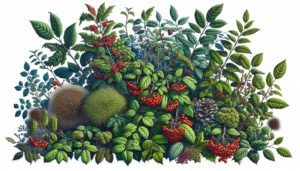Want to support local wildlife? One great way is to plant a hedge for wildlife. This guide covers the benefits of wildlife hedges, the best plants to use, and tips for planting and maintaining them.
Key Points:
- Planting wildlife hedges enhances biodiversity by providing food, shelter, and movement corridors for various species throughout the year.
- Using native plants like Hawthorn, Beech, and Holly in mixed native hedging supports a greater variety of insects and animals, creating a sustainable and appealing habitat.
- Proper planting techniques, consistent maintenance including mulching, watering, pruning, and pest management are crucial for the long-term success and health of a wildlife hedge.
Benefits of Wildlife Hedges
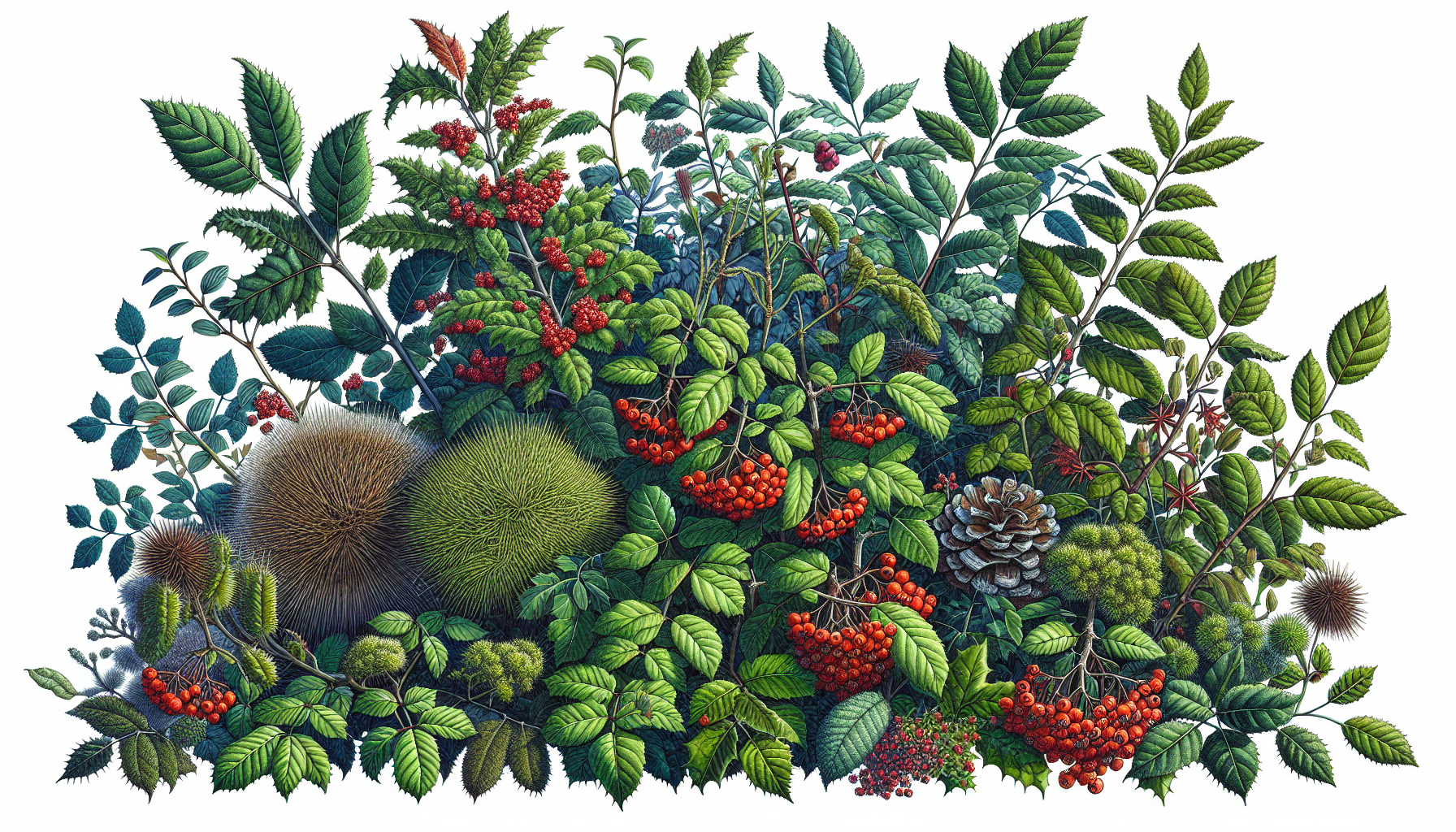
Wildlife hedges are more than just a charming addition to your garden; they are lifelines for many wildlife species. The significant impact on biodiversity due to the loss of hedgerows over the past five decades underscores the importance of planting new hedges. Birds, insects, and small mammals utilise wildlife hedges as vital sources of food, shelter, and nesting opportunities. Unlike fences, which are solid barriers, hedges allow for the free movement of wildlife, offering continuous feeding and breeding opportunities.
One of the standout features of wildlife hedges is their year-round value. By incorporating a diverse range of native hedging plants, these hedges offer a continuous supply of nectar-rich flowers, berries, and seeds that sustain wildlife through the leaner months. For instance, the presence of nectar-rich flowers is particularly important for insects, butterflies, and birds during food-scarce seasons. Additionally, hedges act as natural wind buffers, protecting gardens from strong winds while providing excellent shelter for wildlife.
Moreover, hedges serve as living corridors, allowing wildlife to move safely between different habitats. This connectivity is vital for maintaining healthy populations of various species. Hedges’ ability to diffuse wind rather than block it entirely makes them superior to fences in providing a more stable microclimate for both plants and animals. The dual benefit of privacy and wildlife support makes hedges an excellent choice for anyone looking to create a wildlife-friendly garden.
Choosing Native Hedge Plants
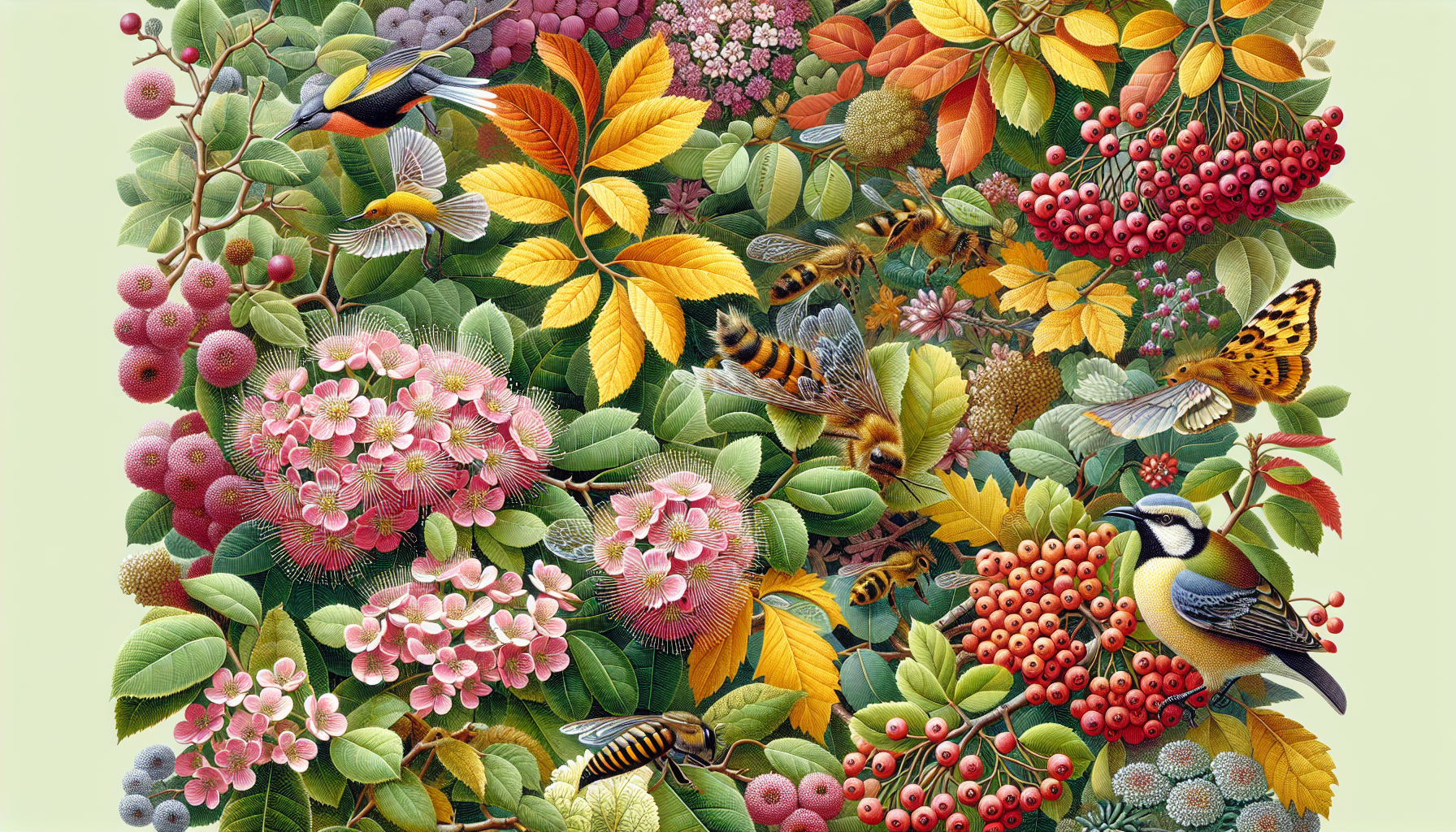
The success of a wildlife hedge heavily depends on the selection of the right plants. Native plants, such as Hawthorn, Beech, and Holly, are particularly beneficial as they support a greater variety of insects and animals compared to non-native species. These native trees and shrubs have evolved alongside local wildlife, making them perfectly suited to provide the necessary food and shelter.
When choosing plants for your hedge, consider incorporating a mix of different species. Such diversity elevates the visual appeal of your hedge while ensuring its year-round utility for wildlife. In the following sections, we will delve into some of the top native hedge species and the benefits of mixed native hedging.
Top Native Hedge Species
Native hedge plants, also known as native shrubs, are the backbone of any wildlife-friendly hedging project. Some excellent choices for creating a rich and diverse habitat include:
- Hawthorn: with its thorny branches and prolific white flowers in spring, it not only provides food through its berries but also offers secure nesting sites for birds.
- Blackthorn
- Beech
- Holly
Some plants that you can incorporate into your hedge to create a thriving environment for wildlife are:
- Blackthorn, which produces dense growth and berries that attract various wildlife species
- Beech, both green and purple varieties, which offer seasonal interest with vibrant foliage that turns copper in autumn and is retained throughout winter
- Holly, an evergreen with spiny leaves and red berries, which provides year-round interest and is a critical food source during winter months
By incorporating these plants into your hedge, you can create a habitat that supports and attracts wildlife.
Mixed Native Hedging
Creating a mixed native hedge involves combining various native species to maximise the hedge’s wildlife value. A native hedgerow can contain hundreds of wildlife species, forming protected corridors that facilitate movement between habitats. By integrating different species that flower and fruit at various times, you provide a continuous supply of food and shelter throughout the year.
For instance, some trees that support wildlife include:
- Hornbeam, which supports over 170 species of insects and provides robust shelter and nesting options for birds
- The Wayfaring tree, with its flowers and fruits, supports insects like beetles and bees and offers a food source for birds and small mammals
- Dogwood, which attracts numerous insects and its berries are favoured by birds such as thrushes and robins
By thoughtfully selecting and combining these species, you can create a vibrant and dynamic hedge that supports a rich diversity of wildlife.
Planting Your Wildlife Hedge
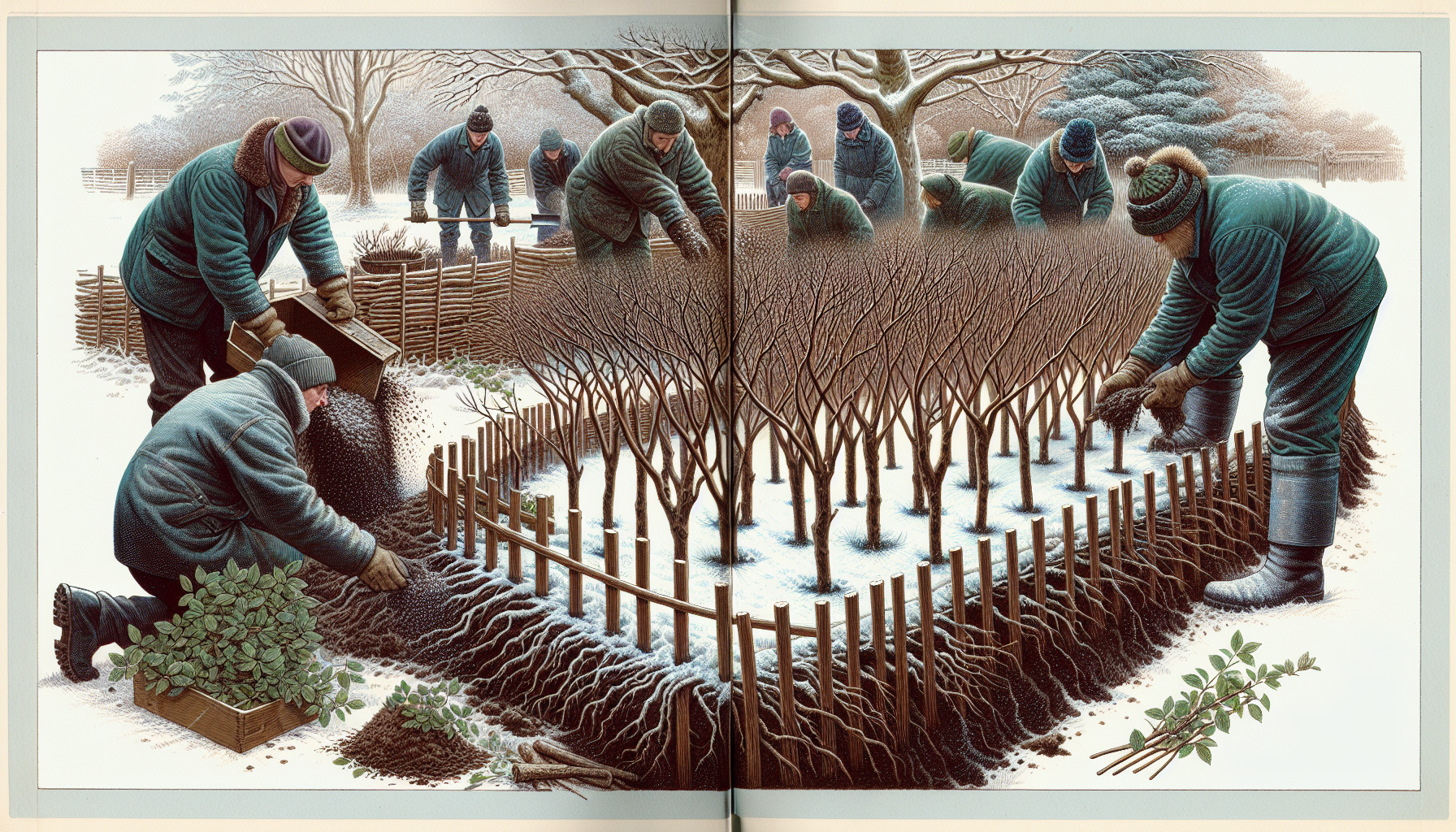
Correct planting is key to the long-term success of your wildlife hedge. The best time for planting is between November and March. During this period, the ground is neither waterlogged nor frozen, providing optimal conditions for successful planting. Using bare-rooted plants can be more economical, but it’s important to ensure their roots are not exposed for too long during planting. Positioning the plants in a double row, spaced about 30 cm apart, and either in a straight line or a soft wave can create a more natural look. For mixed native hedges, planting three of the same species per meter alongside others can offer a balanced and diverse hedge.
To enhance the growth and health of your new hedge, applying a thick mulch or mat at the base will help keep weeds at bay and maintain soil moisture levels until the plants are well-established. In the following subsections, we will go into more detail about preparing the site, planting techniques, and the importance of adding mulch.
Preparing the Site
A successful wildlife hedge fundamentally relies on proper site preparation. Begin by digging a trench about a meter wide, incorporating garden compost or well-rotted manure to enrich the soil. This organic matter provides essential nutrients that support the plants’ growth and health.
Avoid planting in waterlogged or frozen ground to ensure the young plants can establish themselves effectively.
Planting Techniques
When planting your hedge, follow these steps:
- Space the plants approximately 30 cm apart in a double row.
- Angle the plants at around 45 degrees to establish a hedge that is dense from the base up.
- This close spacing encourages the hedge to fill in quickly, providing immediate benefits to wildlife.
- For mixed native hedges, include three plants of the same species per meter to ensure a balanced and varied hedge.
After planting, firm the soil with your boot and water the plants generously to help them settle in. Reducing the height of the plants by half after planting can help mitigate wind damage and promote quicker root establishment.
Adding Mulch
To maintain the health of your wildlife hedge, mulching is a necessary step. Applying a layer of mulch, such as bark or grass cuttings, around the base of the plants helps suppress weeds and retain soil moisture. This practice ensures that your hedge remains hydrated, especially during dry periods, and supports the overall growth and vitality of the plants.
Maintaining Your Wildlife Hedge
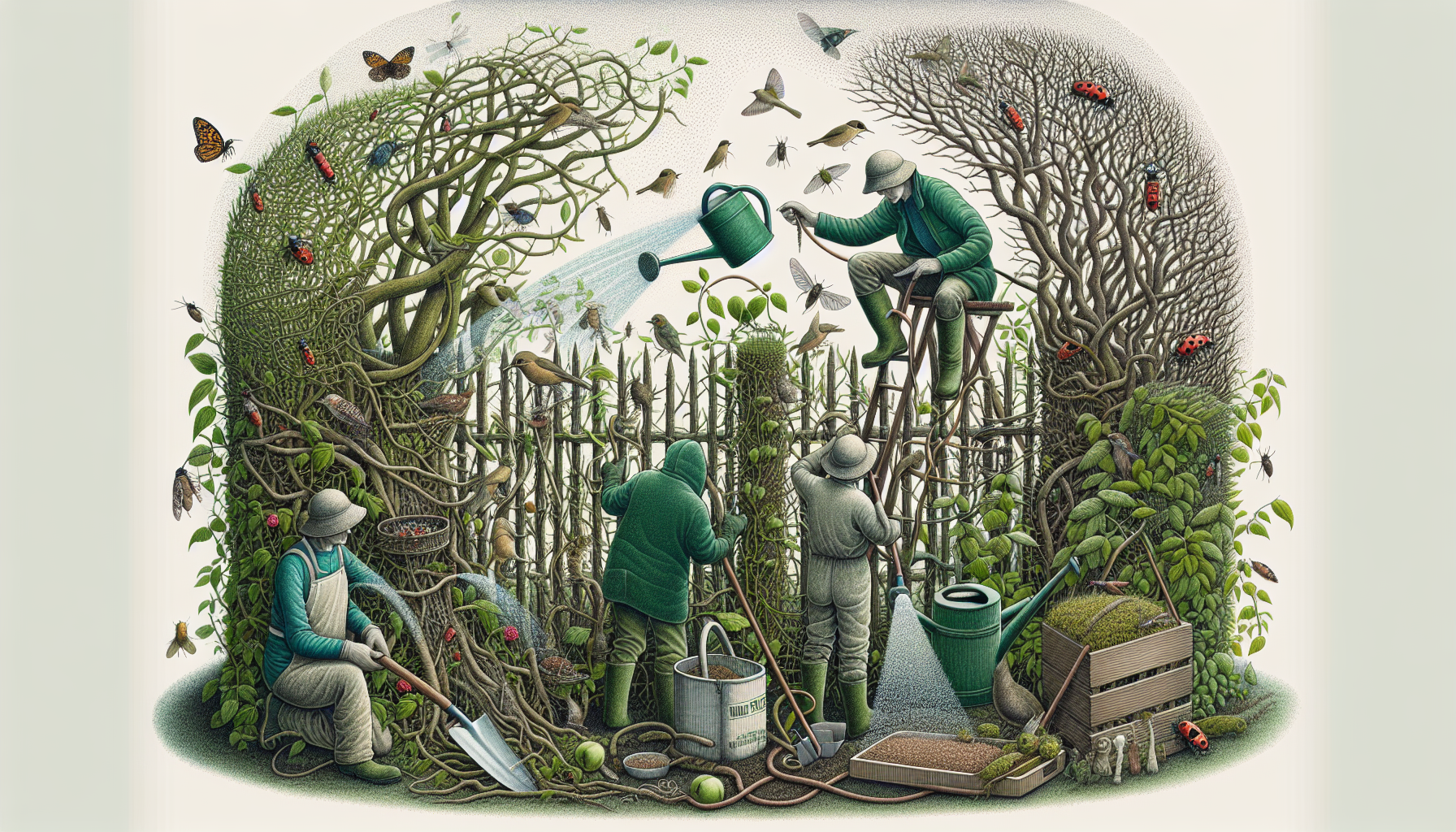
Upon planting your wildlife hedge, its health and longevity depend on continual maintenance. Regular pruning, watering, and feeding help maintain a dense and healthy growth that supports a variety of wildlife species. Maintaining soil moisture levels and promoting bushy growth require mulching around the hedge base. Keeping the hedge free from weeds and grass during the first summer prevents competition for resources.
In the sections that follow, we will explore the specifics of watering and feeding, pruning guidelines, and pest and disease management.
Watering and Feeding
To establish strong roots, newly planted hedges need consistent watering. Water the hedge well after planting and ensure it receives adequate moisture during late summer by watering deeply if rainfall is insufficient.
This practice is vital for the hedge’s long-term health and productivity.
Pruning Guidelines
To encourage new growth and maintain your hedge’s shape, regular pruning is necessary. Cutting shrubs back to 45-60 cm above the ground in the first spring will encourage bushy growth, promoting a healthier and fuller appearance. Regular pruning in early spring helps remove dead or damaged branches and shapes the hedge.
Trimming the hedge on a two to three-year rotation ensures that it continues to produce flowers and berries, which are crucial food sources for wildlife. Avoid heavy pruning during the peak bird nesting season, from March to September, to prevent disturbing nesting birds.
Coppicing sections of the hedge in winter can rejuvenate older hedges by encouraging vigorous regrowth.
Pest and Disease Management
Early detection and prevention of diseases by regularly inspecting your hedge can help avoid their spread. Managing pest infestations that may develop over the summer months is crucial to maintaining the health of the hedge and the wildlife it supports. Effective pest and disease management ensures that your hedge remains a beneficial habitat for various species.
Enhancing Your Hedge for Wildlife

The value of your hedge to wildlife can be significantly increased through enhancement. Incorporating rambling plants and ornamental shrubs can attract more wildlife and diversify the hedge’s appeal. Interwoven branches provide safe nesting and roosting places for small birds like thrushes, finches, robins, and wrens.
In the following subsections, we will explore how to incorporate climbers and ramblers, as well as planting hedge foot plants.
Incorporating Climbers and Ramblers
Climbers and ramblers like Ivy and Honeysuckle, which are among various plant species, bring flowers for pollinators and berries for birds, enhancing biodiversity. These plants can provide additional shelter for birds and other wildlife, making your hedge even more attractive to various species.
Dogwood and roses are also effective choices for incorporating into hedgerows to attract wildlife.
Planting Hedge Foot Plants
Planting hedge foot plants like primroses and knapweed at the base of your hedge creates ground cover that supports wildlife. These flowers offer nectar and pollen for bees and other beneficial insects, while tussocky grasses provide safe habitats for beetles, spiders, and other invertebrates.
Ensuring the wildflower mix is of genuine native UK provenance will maximise its benefits for local wildlife.
Seasonal Care Tips
Supporting plant health and encouraging wildlife requires different tasks throughout the year as part of seasonal care for your wildlife hedge. From early spring pruning to late summer maintenance and winter protection, each season requires specific actions to keep your hedge thriving.
In the following subsections, we will discuss the tasks you should undertake in early spring, late summer, and winter.
Early Spring Care
In early spring, cut shrubs back to 45-60 cm above the ground, as this encourages bushy growth and helps remove any dead or damaged branches.
Applying a balanced fertiliser provides essential nutrients for strong growth.
Late Summer Maintenance
During late summer, trim back overgrown areas to maintain the hedge’s shape and health, promoting dense growth.
Avoid heavy trimming to allow for berry production, which is vital for wintering birds.
Winter Protection
In winter, protect your hedge by covering young or vulnerable plants with burlap or other protective material to shield them from frost. Applying a layer of mulch around the base insulates the roots and ensures the hedge provides sufficient shelter for wildlife.
Summary
Creating a wildlife hedge is a rewarding endeavour that benefits both your garden and local biodiversity. By choosing native plants, planting correctly, and maintaining your hedge through seasonal care, you can create a thriving habitat for a variety of wildlife species. Regular pruning, watering, and pest management ensure that your hedge remains healthy and continues to provide essential food and shelter for birds, insects, and small mammals.
Let us all take a step towards a greener future by planting wildlife-friendly hedges in our gardens. Not only will you enjoy the beauty and privacy they offer, but you will also play a crucial role in supporting the environment and preserving biodiversity.
Frequently Asked Questions
What are the best native plants for a wildlife hedge?
Consider planting Hawthorn, Blackthorn, Beech, and Holly for a diverse and beneficial wildlife hedge that offers food and shelter for various species throughout the year.
When is the best time to plant a wildlife hedge?
The best time to plant a wildlife hedge is between November and March when the ground is not waterlogged or frozen. This timing helps ensure successful establishment and growth.
How should I space the plants when planting a mixed native hedge?
When planting a mixed native hedge, space the plants approximately 30 cm apart in a double row to achieve a balanced hedge. This will also involve including three plants of the same species per meter along with other species.
How often should I prune my wildlife hedge?
You should prune your wildlife hedge in early spring to encourage new growth and shape the plants. Trim the hedge on a two to three-year rotation to ensure it continues to produce flowers and berries for wildlife.
How can I enhance my hedge to attract more wildlife?
To attract more wildlife to your hedge, incorporate climbers like Ivy and Honeysuckle, and plant hedge foot plants like primroses and knapweed. These additions will provide flowers for pollinators, berries for birds, and safe habitats for insects and small mammals.


